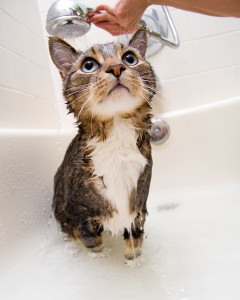All cat owners dread bath time, just like parents with toddlers do. Bathing a cat can be a traumatic and life-endangering prospect for you and your beloved pet. While Fluffy may seem sweet and demure 99% of the time, all bets go out the window when you hold them in your arms and approach a tub, a sink or other body of water. The unfortunate reality for pets and owners alike is that your cat will occasionally need to be bathed in order to maximize health and reduce the likelihood for potential problems. While it may not be an idea that you enjoy, it’s one that will eventually need to be done.
In order to minimize harm to you and your animal, the following tips and suggestions are helpful to make bath time a success – if not a pleasure for all parties involved.
 1. Trim nails prior to bathing
1. Trim nails prior to bathing
Cat claws can be deadly weapons. If you’ve ever held your loving pet in your arms and then dumped out a glass of water or turned on a faucet, you’re probably aware of the dangers. It behooves you to trim your cats nails (all of them, not just the front ones) prior to addressing the issue of a bath. Not only can you avoid having your arms ripped to pieces, you can calm your cat as well. Don’t go straight from the claw-trimming to the bathtub, either. Let your cat relax before showering water over them. Some cats respond to nail-clipping calmly, and others see it as an act of war.
2. Plan your bath time accordingly
Bath time should not immediately follow playtime. If your cat is calm, they’re likely to respond to the prospect of bathing better than if they’re hyped up on catnip or have just played run and dash with their siblings.
3. Start with a calm brushing
Chances are you don’t want a huge mess of hair all over your sink or tub. Before approaching the bath, make sure to remove any loose fur. Brushing a cat also calms them and makes them feel safe and loved – and they’re much more likely to approach the situation calmly.
4. Give them a leg to stand on
Wet surfaces can easily become slippery, and if your cat doesn’t have something steady to stand on, they can become even more freaked out by the process. Put a slip-proof mat or cloth in the bathtub or the sink to allow them the ability to feel secure in a situation that they definitely don’t like.
5. Avoid sensitive areas
You probably wouldn’t want someone to just dump a cup of water over your head, carelessly ignoring the fact that water and soap in the eyes is unpleasant. When initially moistening your pet, take care to avoid getting water directly in their eyes, ears or nose. They will appreciate your sensitivity and will become less likely to try to bite or claw their way free – especially since you’ve already trimmed their nails (right?).
6. Use the correct products
When bathing a cat, don’t make the assumption that your shampoo will work just as well as shampoo especially designed for cats. Human shampoo can dry out your cat’s skin and make it more sensitive, and you wouldn’t want to use a product that could potentially harm them. Make sure to follow the directions for the shampoo that you’re using as well – most cat shampoos require dilution prior to use. Using a solution that is too highly concentrated could have potentially harmful effects.
7. Thoroughly clean the face
Instead of dousing your cats’ face with lukewarm (never hot) water, use a washcloth to gently clean the area. If your cat’s face is particularly dirty, you may have to use shampoo that is even more diluted, but generally regular water works just fine.
8. Rinse thoroughly
You’ll want to make sure that you get all of the shampoo off of your pet before you can call your bath a success. A good rule of thumb is to rinse twice as long as you have shampooed. If shampoo is left on the skin or fur to dry, it attracts dirt and dust and makes the entire point of the bath a failure. Dried shampoo can also hurt and dry your cat’s skin and make it uncomfortable for them – and you definitely don’t want them to ingest it unintentionally as they try to lick the remnants of the bath (and the memory of it) away for good.
9. Dry down
Don’t allow your cat to run away as soon as the water part is over. If they’re left sopping wet in an area that is cold or drafty, it’s easy for them to get sick. Wrap them in a clean towel and remove as much of the excess water as possible. This is also a good time for you to hold them close and reassure them that the hard part is over. 
10. Reward for a job well done
If you’ve successfully completed the process, you may be ready for a strong drink – but your cat deserves a reward too. While they may never associate a bath with fun, make sure that they’re aware of how appreciative you are to still be (mostly) intact. Speak calmly to them, reassure them – and as soon as they trust you enough to be within arms’ reach of you again, give them a lot of reassuring petting as well. Leave a treat for them in their bowl or near you and let them know that they did a good job.

Please contribute to this article discussion and post a comment below...
Powered by Facebook Comments